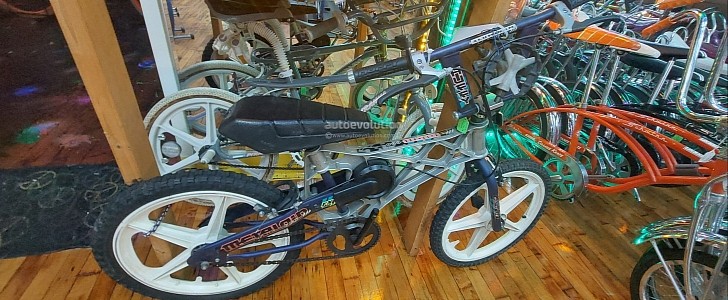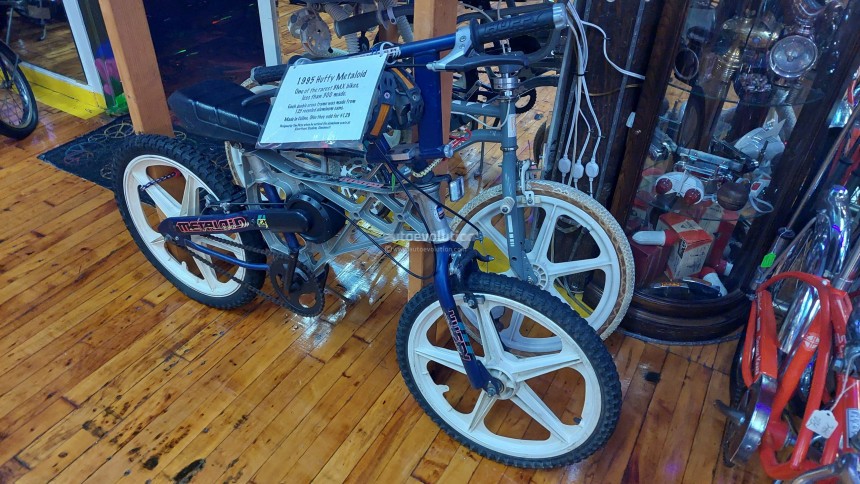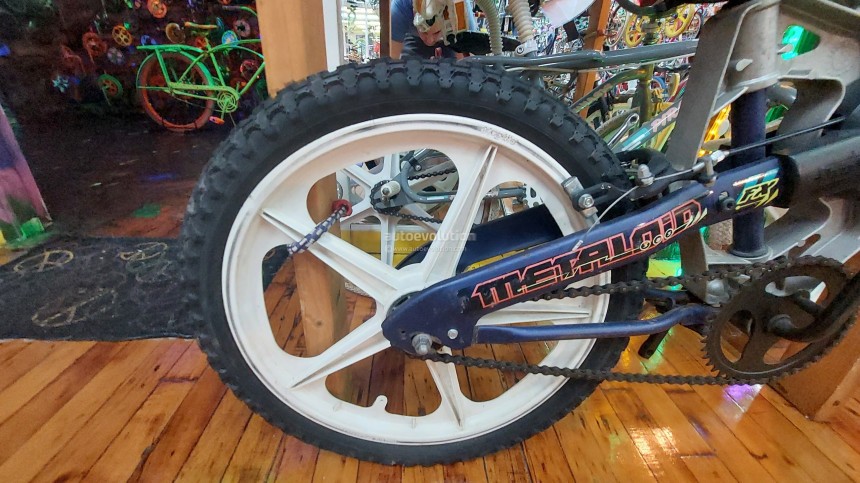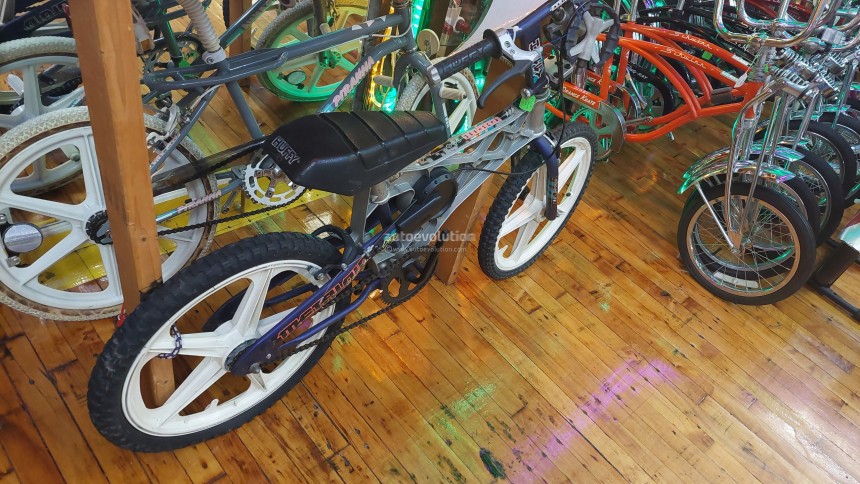We can't hear the end of it about environmental sustainability in 2022. After years of constant exposure, you might find most of it to be disingenuous corporate hogwash. So much so that you're liable to be justifiably jaded when you do actually happen upon a genuinely well-thought-out environmentally sustainable machine.
Move aside, Fisker Karma. The 1995 Huffy Metaloid was a BMX bike honed from mostly recycled materials over a decade before it was fashionable to do so in cars. Lots of motor vehicles and bicycles claim to be sourced from environmentally sustainable materials, but in proportion to its overall size and weight, it's safe to say this ultra-rare bike with less than 300 models made in the 95 model year sure beats anything from the auto industry.
But first, a brief little history of Huffy, a name most petrolheads from the car enthusiast side of things may have never heard of. But believe us, its roots date back to before even the very earliest big three American automakers. Founded by George Huffman in Dayton, Ohio, before the turn of the 20th century, Huffy is one of the longest continuously operating bicycle manufacturing companies anywhere in the world.
Huffy was and still is a company on the knife-edge of contemporary BMX R&D. What they're arguably the most famous for was being around 50 years ahead of the curve when it came to electric bicycles. Though it must be said, the component they chose to electrify was not the drivetrain but rather a radio/stereo integrated into the frame of the bike.
Apart from this, they've had their hands in every facet of bicycle production in a variety of different market segments. Be it road cruisers, tandem bikes, competitive race bikes, and of course, BMX. By the time the mid-90s came around, perhaps only Schwinn, Trek, or Cannondale had anything close to the name recognition that Huffy bikes did.
If there were a proverbial American big four of the bicycle industry to mirror that of Detroit's big three, these names would be sure to be included. By 1995, the first whisperings of an impending environmental crisis were already making their rounds around newspapers and TV news.
Even so, global automakers, American ones especially, lent about as much credence to newly emerging greenhouse gas emissions data in the day as they would letting one rip in a movie theater when there are only three other people in the whole room. So to say, not very perceptively at all.
Just look at what happened when GM tried to build an EV with lots of recycled materials in its construction? The whole project wound up in the recycling bin by the end of the 90s. All the while, Huffy was about to show the world how to do environmental sustainability the right way. Lo and behold, what we have before us today, is the Huffy 1995 Metaloid FX.
Lots of brands make slogans and ad campaigns based on sustainability figures for their vehicles, but this bike need not use cheesy slogans. The proof is all in the numbers. Most common bicycles used countless tons of bulk-purchased, freshly-refined material to make products from freshly processed new metal.
But in the Metaloid, exactly 125 recycled 12-ounce (354.8-milliliter) aluminum soda cans were used in the construction of the Metaloid's trestle-frame, a more sturdy and capable configuration than a standard aluminum tube frame.
Strong enough, in fact, to be factory certified for riders rated from 30 pounds (13.6kg) up to a whopping 300 pounds (136.07 kg). For a bike that falls well short of full-sized, that's a figure worth celebrating. These bikes were manufactured in Celina, Ohio, a short drive away from Dayton.
But because American corporations were still a good 15 years away from being forced to care about long-term environmental sustainability, it's pretty safe to say the American public was less than infatuated with the uniquely sustainable aspects of the Huffy Metaloid.
At a time when BMX was exploding in popularity in America, the Metaloid FX largely sat on the sideline. As mentioned, less than 300 of these mostly recycled frame bicycles were ever made in 1995. Almost assuredly meaning, this one on display at Pittsburgh's Bicycle Heaven is one of the very last left in the world.
Check back for more coverage from our trip to the Bicycle Heaven Museum here on autoevolution.
But first, a brief little history of Huffy, a name most petrolheads from the car enthusiast side of things may have never heard of. But believe us, its roots date back to before even the very earliest big three American automakers. Founded by George Huffman in Dayton, Ohio, before the turn of the 20th century, Huffy is one of the longest continuously operating bicycle manufacturing companies anywhere in the world.
Huffy was and still is a company on the knife-edge of contemporary BMX R&D. What they're arguably the most famous for was being around 50 years ahead of the curve when it came to electric bicycles. Though it must be said, the component they chose to electrify was not the drivetrain but rather a radio/stereo integrated into the frame of the bike.
Apart from this, they've had their hands in every facet of bicycle production in a variety of different market segments. Be it road cruisers, tandem bikes, competitive race bikes, and of course, BMX. By the time the mid-90s came around, perhaps only Schwinn, Trek, or Cannondale had anything close to the name recognition that Huffy bikes did.
Even so, global automakers, American ones especially, lent about as much credence to newly emerging greenhouse gas emissions data in the day as they would letting one rip in a movie theater when there are only three other people in the whole room. So to say, not very perceptively at all.
Just look at what happened when GM tried to build an EV with lots of recycled materials in its construction? The whole project wound up in the recycling bin by the end of the 90s. All the while, Huffy was about to show the world how to do environmental sustainability the right way. Lo and behold, what we have before us today, is the Huffy 1995 Metaloid FX.
Lots of brands make slogans and ad campaigns based on sustainability figures for their vehicles, but this bike need not use cheesy slogans. The proof is all in the numbers. Most common bicycles used countless tons of bulk-purchased, freshly-refined material to make products from freshly processed new metal.
Strong enough, in fact, to be factory certified for riders rated from 30 pounds (13.6kg) up to a whopping 300 pounds (136.07 kg). For a bike that falls well short of full-sized, that's a figure worth celebrating. These bikes were manufactured in Celina, Ohio, a short drive away from Dayton.
But because American corporations were still a good 15 years away from being forced to care about long-term environmental sustainability, it's pretty safe to say the American public was less than infatuated with the uniquely sustainable aspects of the Huffy Metaloid.
At a time when BMX was exploding in popularity in America, the Metaloid FX largely sat on the sideline. As mentioned, less than 300 of these mostly recycled frame bicycles were ever made in 1995. Almost assuredly meaning, this one on display at Pittsburgh's Bicycle Heaven is one of the very last left in the world.















